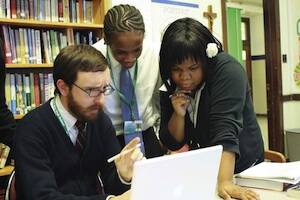Before Stephanie Gullotti started working at MercyFirst human services agency in Brooklyn, N.Y., she thought the job would be a temporary stop on her way to a career in health care. But since last August, when she began her work there with children in foster care, she has gained experience organizing workshops about education, employment and health for teens; she has built relationships, planned trips and encouraged high-schoolers to apply for college. “I came into this thinking I’d learn something and maybe take that to whatever else I do in the future, but I enjoy so much of what I’m doing now, I’m torn,” she said. Ms. Gullotti loves her job for many reasons, but a big paycheck isn’t among them.
As a full-time volunteer for the agency through the Mercy Volunteer Corps, Ms. Gullotti, 23, receives a stipend of $210 a month, $110 of which is for groceries for her volunteer community, which consists of herself and one other volunteer. The two women receive housing and health insurance from M.V.C., which is based in Gwynedd Valley, Pa., and live together while trying to put into practice in their daily lives the tenets of simple living, community, social justice and spirituality.
While this lifestyle might seem radical to some, it makes sense to more and more young adults who are seeking faith-based volunteer programs that match applicants with full-time job placements lasting anywhere from one week to two or more years. The volunteers often choose this path as a way to “give back,” to build on a short-term service experience or to explore career options. Most live on a small stipend and in a community with other like-minded volunteers.
Over 13,000 individuals volunteered through faith-based programs between 2008 and 2009, according to a survey by Catholic Network Volunteer Services. Of these volunteers, nearly one quarter served for nine months or more. The increasing popularity of these faith-based volunteer programs among adults under 25 reflects a general increase in the number of young adults in the United States who choose to volunteer for any significant length of time, which rose from 7.8 million to 8.2 million from 2007 to 2008, according to the Corporation for National and Community Service. But despite the abundance of individuals looking for full-time volunteer positions after college, the total number of faith-based programs is declining, and many programs are seeking new sources of funding in the wake of the U.S. economic downturn.
Expanded Need, Diminished Resources
Since 2004, the number of programs registered as members of C.N.V.S. has fallen from 236 to 182. Of those remaining, 175 offer service opportunities lasting nine months or more in both domestic and international placements. The largest lay, Catholic, long-term volunteer program, and one of the oldest, is the Jesuit Volunteer Corps, headquartered in Baltimore. This year applications for J.V.C. have risen dramatically, up 36 percent since last year. The main office stopped accepting them altogether after receiving 650 applications for 370 placements. The organization expanded both its international and domestic placements by 12 percent in an effort to meet the demand. But this, in turn, has presented a new set of challenges.
“The need is expanding, and the number of people who want to volunteer is expanding,” said Kevin O’Brien, the president of the Jesuit Volunteer Corps. “What’s not expanding is the resources.” Even with an alumni base of over 12,000 and several full-time staff members, J.V.C. has not yet met its fund-raising goals for this year. “We are trying to do new things and go back to our alumni for support,” he said. “We’re writing more grants. It’s not dire, but the rate at which we can expand is constrained by the economic realities.” Mr. O’Brien says he has directed many qualified applicants to other programs with similar values.
The economic downturn also has affected programs that receive the bulk of their funding from a single religious congregation. Shrinking orders must rethink their budgets as many of their members reach retirement age. Meanwhile the growth of secular nonprofit-based programs creates more options for potential volunteers. Today half of all faith-based post-graduate volunteer programs are run by religious congregations, down about 20 percent from 14 years ago, according to Jim Lindsay, executive director of C.N.V.S.
This July will mark the end of the Providence Volunteer Ministry, a program run for 22 years by the Sisters of Providence of Saint Mary-of-the-Woods, in Indiana. As the ministry’s first lay director, Julie Szolek-Van Valkenburg worked for several years to build the program; she instituted spiritual direction and retreats for the volunteers. But the community leadership decided to close the program because of its cost, difficulties in housing the volunteers, the declining number of religious sisters and losses from the religious community’s investments. “The volunteers had a better attitude than I did,” said Ms. Szolek-Van Valkenburg, describing her reaction to the decision. “They said that this ministry as it’s known is closing, but there will be something else that will come.”
In spite of economic and logistical difficulties, new volunteer programs continue to be launched, and 17 people attended the most recent C.N.V.S. yearly formation workshops for potential new program leaders. Among last year’s crowd was Ellen Mommarts, the first executive director for the Norbertine Volunteer Community, sponsored by the Norbertines of St. Norbert Abbey in De Pere, Wis. She spent the past year recruiting, securing housing, developing a budget and setting up relationships with agencies in a culturally diverse neighborhood of Green Bay. There the organization’s six volunteers commit themselves to 30-hour work weeks with various agencies and 10 hours of community development within their neighborhood.
While agencies in Green Bay are familiar with government programs like AmeriCorps, the Norbertine volunteers are the first in the area sponsored by a religious community. Currently, the Norbertines do not ask participating agencies to pay any part of the cost of a volunteer, which surprises many agencies, who welcomed the help. “When they realized we were serious, they were all over it,” Mommarts said. “We know adjustments will need to be made based upon the needs of the neighborhood. That’s…the example St. Norbert gave to the order: meet the needs of the people where they’re at.”
A Culture of Service
Word of mouth and the Internet remain the top ways by which college students learn about a particular program, but it takes more than good public relations and recruiting tactics to inspire individuals to join.
“We’ve talked a lot about what we can do to create more of a culture of service, where [long-term volunteering] is not seen as unusual, but something that we would like everyone to at least consider,” said Jim Lindsay of C.N.V.S. “People are very concerned…about finances, student loans; many have to convince their parents that this is something worth doing. But I think we’re finally getting to the point where a year of service isn’t a year off, a gap year. It’s a year of real-world experience, and its an excellent way to start off a career [or]…to live out one’s faith in service to the poor.”
According to C.N.V.S. statistics, 44 percent of volunteers enter the workforce immediately after completing their service; of those, 53 percent choose fields in education or social work. Another 12.2 percent enter graduate schools, where 61 percent study medicine, social work or education. Yet volunteering is not just for those interested in being a teacher or a caseworker. “For some, volunteering allows a person to really pursue a career; for others, they learn transferrable skills, life skills because of it,” said Mike Goggin, executive director of the St. Vincent Pallotti Center in Washington, D.C., which offers prayer resources, networking opportunities and newsletters to prospective, current and former volunteers. “I think a lot of people who choose to do long-term volunteer service have financial means to be able to spend a year not working for pay.... Living simply and in a very rural community or a foreign country or a very urban setting can sometimes be quite a different experience for them.”
John Mullman, 49, fully acknowledges that he was pushed outside his comfort zone when he joined J.V.C. in 1982 after graduating from the College of the Holy Cross in Worcester, Mass., with a degree in economics. At the time, he had rarely traveled far from his hometown on Long Island, so his placement as a teacher and after-school program coordinator in Washington, D.C., seemed like a true adventure.
“There’s an element of it that was appropriately uncomfortable, and that’s part of the value of the experience,” he said. “It’s one thing for you to live on $60 a month for a year, when at the end of the year you can choose to not do that,” he said. “The people you’re working with do not get that choice. And that affects you.” Today, Mr. Mullman, who is married to another former Jesuit volunteer, is in the money management business and on the J.V.C. board of directors. “The lessons you learn from that stick with you. The idea of giving back to those less fortunate than you is something we’ve given to all our children, I hope.”
For some, the transition from the life of a volunteer to whatever comes next can be difficult. “The volunteers have been profoundly changed, then [they] go home and try to talk about it, and it’s, ‘Yeah, great. O.K.; we’re going to get pizza for dinner.’ Or, ‘Oh, the do-gooder is home,’” said Marian Uba, executive director of the Mercy Volunteer Corps. “We try to help the volunteers communicate their experience in a constructive way.” She said teaching them to “ritualize their goodbyes” is part of the ministry, too. Many former volunteers feel at home in jobs or communities that uphold the values of their volunteer program.
Cinnamon Sarver’s volunteer experience inspired her to “delve more deeply into issues of voluntary poverty.” After serving as a therapist and case manager at a mental hospital through Channels, a now-defunct program associated with the Diocese of Seattle, Ms. Sarver, 39, joined a Catholic Worker community. “It was really hard for me to imagine finding full-time work where I wasn’t going to compromise some key values by paying taxes to a government that would support war, capital punishment and abortion,” she said. She has since spent six years at various Catholic Worker houses, seven years teaching full time, and recently she completed a master’s degree in theology from the University of Notre Dame, which is named by many volunteer programs as the top school for volunteer recruitment. Despite her qualms, Sarver found that joining the labor force has its upside. “I have been able to explore the side of myself that is an educator, and I have a lot of talents in that area that I wasn’t able to fully explore in my volunteer experiences,” she said.
For Ellen Derby, 26, the value of community stayed with her after two years as a teacher in Micronesia through J.V.C. She stayed for an additional year serving as the school’s principal. In the fall, Derby will become a religion teacher and campus minister at a California high school. She still enjoys discussing her volunteer experience, but is sometimes frustrated by those who try to label her experience as time off.
“People say, ‘It’s so great that you’re taking time out to do this,’ and I want to say, ‘I worked the hardest I ever had in my entire life,’” she said. “I went to bed with the sun and got up with the sun every day. It was by no means a vacation.... [I]n going there I didn’t realize how much it would become a part of my life. It’s not a sidestep off my path. This volunteer experience was part of the road.”








